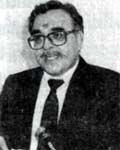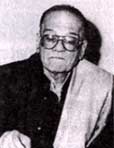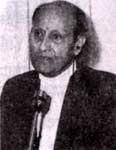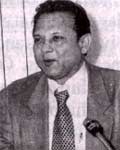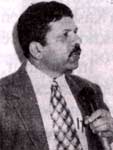EVENTS
A Pilgrimage To Kailash Mansarovar
|
|
Mr. C.V. Gopinath, Dy. Director General (TS), Bharat Sanchar Nigam Ltd. who has visited Kailash and Mansarovar twice, has collected valuable audio-video material of this region of the Himalays. He made an audio-visual presentation of his impressions in a lecture of February 15. The annual Kailash Mansarovar Yatra is organized by the Ministry of External Affairs, in collaboration with Indo Tibet Border Police and Kumaun Vikas Nigam Limited, a public sector undertaking of the UP Government. The yatra, to Mount Kailash and Lake Mansarovar in Tibet is performed between the months of June and September. This year the Yatra is beginning of June 1st. Pilgrims have to apply to the External Affairs Ministry. Mr. Gopinath’s presentation was aimed at projecting the rich cultural heritage, religious fervor and spiritual aspects of the yatra, especially with respect to places and events. It also highlighted the arduous journey one had to undertake to realize one’s lifetime ambition and goal. The whole trekking route right from the base camp Dharchula passing through camps at Panju, Sirka, Gala, Malpa, Bundi gunji, Kalapani and Navi Dang before crossing over to Tibet on the Indian border at Lipu Lake Pass was projected to show the Indian content of the pilgrimage. The sacred mount Kailash and sacred lake Mansarovar the culmination of the yatra, were presented by a person who was himself an involved Yatri and not as a mere documentary.
|
|
|
India’s development as knowledge societyDr. K. Venkatasubramanian, Member, Planning Commission, delivered a lecture on the emergence of India as a knowledge Society. (January 18) He said the knowledge Society is a "work-in-progress" requiring significant investment in harnessing skills, technology and learning. Knowledge Society is a society where creating, sharing and using knowledge are key factors in a the prosperity and well being of its people. This contrasts with earlier societies such as the agriculture society (when agriculture was the key to survival) and industrial society (when mass production of goods generated most of the wealth). In the emerging Knowledge Society, as much as, if not more than land, labour and capital, knowledge is the key to creating wealth and improving the quality of life. Citing a five-point agenda as unveiled by Prime Minister Shri A.B. Vajpayee, Dr. Venkatasubramanian said the idea of the knowledge society has been spreading rapidly around the world. So much so, it has been described as a "Knowledge Revolution". The speaker holds a doctorate in Economic and is a recipient of several national and international awards.
|
|
|
Kashmir Art in Pahari School of PaintingThe Pahari school of art, in truth has its origins from Kashmir. It is in fact the gift from a family of artistes, Prof. P.N. Kachru said in his lecture (Feb.27) "Kashmir Art and Pahari school of Painting". Prof. Kachru is a well-known artist from Kashmir. Describing the Pahari Art as a pot-Mughal phenomena, he said it is one of the outcomes of cultural rejuvenation after the Himachal princedoms regained independent status after the decline of the Mughals. This art form was further vitalized and reinterpreted by Kashmir school and its fugitive painters who sought refuge from the threat of prosilitization. The family of Rajanka (Razadan or Raina) Brahmins swept the entire region with their artistic genius and were responsible for the introduction of romantic movement in all the principalities of Jasrota, Basohli, Guler, Jummu, Chamba, Noorpur and Kangra. The family swept, dominated and led the movement through 1658 to end nineteenth century. Pandit Seu Raina, the ancestor of this family, left Kashmir under the threat of forced conversion, sometime in 17th century and settled in Guler during the reigns of Raja Dalip singh and Raja Bikram Singh under the princely patronage or Raja Dalip Singh. Here, the style richly vibrated with an ideal amalgam of pahari folk and Kashmir Pala style, later on practiced effectively in Guler, Basohli and Jummu principalities. Giving an elaborate history of the Pahari art, Shri Kachru chronicled the distinguished artists. Manaka, the elder son of Pandit Seu, who painted Jaideva’s Geeta Govinda, he mentioned was among the most gifted painters of this tradition. Pandit Seu’s younger son Naisukh’s entry into the royal court of Jummu changed the entire mood of the tradition. There now was a marked feeling for geometric structure, strong colour and vitality. The various distinct styles of the pahari art are named after their geographic prevalence, namely Jummu, Chamba, Basohli, Guler and Jasrota. The sons and grandsons of this family continued with the great tradition, serving various royal courts and expanding the area of influence throughout Himachal. Prof. Kachru said in all the Pandit Seu family produced 46 children, who were all artists and with their genius penetrated deeply into the milieu of all Himachal principalities of their adopted home.
|
|
|
Defining Indian Diaspora – a talkBharat Gupt, Assciate Professor (English) in Delhi University believes that the 21st century has undergone a diasporic change. In a lecture (Jan.3) on ‘Indian Diaspora and the Nation:Prospects and Pitfalls, he said Nationality is now less topographic and more emotional. The diasporic transition has been from economic to cultural work force. In this context, he discussed the four Indiasporas: of Africa, Far East, Gulf and Euro-American. Dr. Bhrat Gupt teaches in the College of Vocational Studies. He has a wide area of interest-theatre, music, culture and media studies. he has lecture on music at various universities in India and abroad and published two books related to music and dance.
|
|
|
Indian Classical Music needs systematic preservationChetan Pandit made a powerful plea for the systematic preservation of Indian classical music. In a lecture (Jan.22) ‘Preservation of Indian Calssica Music, Shri Pandit said because of lack of systematic recording, we have lost the works of several masters who lived in the beginning of 20th Century. Even those of the mid-20th century are in the process of disappearing, he said. At this rate, the recordings of the present-day musicians will be lost in a few decades hence. Shri Pandit said literture and art are preserved with great care. There are libraries and museums. But there has not been an attempt to systematically document and preserve the great variety in Indian classcial music, he said. Shri Pandit, who is an engineer, presently Director (R & D) in the Ministy of Water Resources, has no formal education or training in music, but is a great music lover. He also expressed his anguish that compositions (bandish) by great masters are lost when there is no worthy disciple to carry on the tradition.
|
|
|
TheRole of Arya Samaj In The Propagation Sanskrit LanguageSanskrit is an integral part of Indian culture. One can never think of Indian culture excluding Sanskrit. Because it is only through this scientific language that our cultural heritage has been preserved for us through the times. It does not relate to a particular group or society or region but is for the mankind. For preserving and popularizing this language Arya Samaj has played a very significant and leading role from its very inception. Through its various activities of propagation by learned preceptors, strong propagators and the foundation of Gurukulas it has aroused awareness of Sanskrit among the masses throughout the world. Acharya Vidya Prasad Mishra, in a lecture in Hindi (January 12) spoke elaborately about the role of Arya Samaj in the propagation of Sanskrit. Acharya Mihsra, works in the Kala Kosa division in IGNCA and is an acknowledged authority on rituals and Vedas. Following is the synopsis of his lecture |





